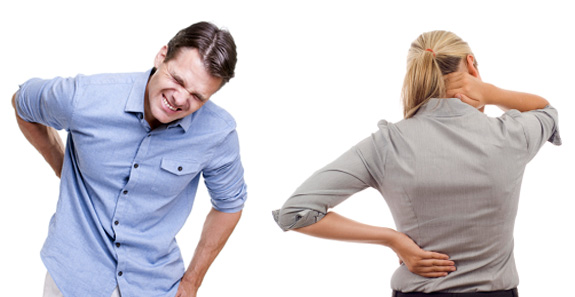Back Pain
What is back pain?
“Oh my aching back” can signal mechanical and, on occasion, even systemic illnesses that generate very real pain. In fact, back pain is associated with over 60 illnesses, and can result in serious disability and escalating medical bills. The good news is most individuals with low back pain improve within a week or two, and 90 percent of these episodes are resolved in eight weeks.
Back pain is just that—pain in the back. It can be localized to the lumbar spine or may radiate into the legs below the knee (sciatica).

What causes back pain?
As a rule, most episodes of back pain are caused by mechanical disorders associated with overuse of the back and spine, or the gradual changes associated with aging. In about 10 percent of the cases, back pain is caused by a systemic illness.
The disorders affecting the low back can be divided into mechanical and systemic disorders. Mechanical disorders that can result in back pain include:
- Muscle strains usually related to sustained physical activity such as shoveling snow or prolonged gardening. Acut strain may also occur when completing a common task from a twisted posture.
- Osteoarthritis resulting from the narrowing of the intervertebral discs located between the vertebrae of the spine. The adjacent vertebrae grow spurs in response to the increasing pressure placed on them. The bony growths can cause localized pain in the low back or leg pain related to nerve impingement.
- A herniated intervertebral disc may cause back pain associated with muscle spasms, but is more commonly severe leg pain related to pinching of the spinal nerve in the low back. The pain radiating down the leg is called sciatica. Disc herniation may cause a loss of function of the nerve that may include a loss of reflex, sensation, or muscle strength.
- Spinal stenosis is a narrowing or the canal or space that the spinal cord occupies. This narrowing has many causes including bone spurs growing around the spinal joints, thickening of spinal ligaments, or bulging of a disc. The narrowed canal squeezes the nerve roots causing leg pain, numbness, or weakness. The pain is increased by standing and walking, and is relieved with sitting.
- Diffuse Idiopathic Skeletal Hyperostosis (DISH) resulting from excessive bone growth which can affect the vertebra from the neck to the lower back.
Systemic disorders that can lead to back pain include ankylosing spondylitis, osteoporosis, tumors, and spinal infections.
Points to remember:
- Low back pain is a common problem and rarely associated with a severe illness.
- The vast majority of individuals heal back pain by remaining active and taking pain‐relieving drugs.
- About 50 percent of individuals are healed in a week or two; over 90 percent are resolved in eight weeks.

 Riverside6180 Brockton Avenue, Riverside, CA 92506
Riverside6180 Brockton Avenue, Riverside, CA 92506 La Sierra4244 Riverwalk Parkway, Riverside, CA 92505
La Sierra4244 Riverwalk Parkway, Riverside, CA 92505

